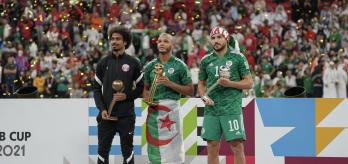The demands on goalkeepers have increased significantly in the last decade, particularly regarding their contributions when their team have the ball. To reach the highest level of the game, modern goalkeepers must be comfortable using both feet under direct and indirect pressure, and must be capable of executing accurate passes over a variety of distances using different distribution techniques.
Variability in distribution
When we analyse variability in distribution, we can see that the UAE were very consistent in their playing style despite using three different netminders throughout the tournament, with 90.7% of their distribution coming from open-play passes. Jordan goalkeeper Yazeed Abulaila demonstrated the most diverse range of distribution: 26.4% from throws, 27% from kicks from hands and 44.4% from open-play passes. Algeria goalkeeper Raïs M’Bolhi also had a solid range of distribution techniques under direct and indirect pressure.
The GTSG also considered whether goalkeepers went longer with their passes due to the options available to them or on account of tactical instructions from the head coach, i.e. as part of their team’s game plan.
Finally, the GTSG considered whether these attributes can be demonstrated consistently. The goalkeepers from the teams that achieved the highest levels of distribution success (highlighted below) succeeded in 80% or more of their attempts in the tournament, regardless of any pressure they may have faced.
While all goalkeepers were analysed in possession, our team identified six individuals in particular to highlight some of the contrasting styles that were evident at the tournament.
UAE
The UAE had a clearly defined playing style, showing determination to build from the back and preferring to go around their opponents’ defensive block, with 61% of their line breaks coming from this approach. They also demonstrated patience, opting to retain and recycle possession rather than to take riskier forward options or break lines.
In their Group B victory over Mauritania, UAE goalkeeper Mohamed Alshamsi demonstrated great awareness and patience in terms of pass selection. According to Pascal Zuberbühler, the 25-year-old custodian showed great personality in his ability to control the game.
He also demonstrated his capacity to play with both feet, meaning that he could avoid direct pressure situations by opening up the pitch on either side. Alshamsi was also very proactive in terms of “offering to receive” and “moving to receive” when his team were attempting to build possession.
Moreover, it has been noted that all three UAE goalkeepers were consistent with the team’s clear playing style, although their passes were not always intended to break lines.
Morocco
Morocco exited the competition at the quarter-final stage, losing 5-3 on penalties to the eventual tournament winners, Algeria, after the game had finished 2-2 following extra time. However, they demonstrated the highest level of distribution success.
Anas Zniti lined up between the sticks for the Atlas Lions in their first two Group C matches and the quarter-finals. Our TSG noted his eagerness to be involved in Morocco’s build-up play and identified them as a team that had a genuine appetite to build with 11 players.
The 33-year-old remained available to receive from his team-mates and attuned to their positioning, but also demonstrated an impressive range in how he distributed the ball.
When Morocco drew their opponents’ press in, Zniti showed great awareness of where the space was opening up on the pitch and had the capacity to deliver the ball to different areas, enabling his team to attack in several ways.
He was also able to execute passes that were conducive to a good first touch by the receiving player and therefore helped to generate attacking momentum.
Sudan
Despite Sudan’s failure to progress beyond the group stage, it was noted that goalkeeper Ali Aboeshren was highly involved in his team’s build-up play. They had a clear strategy of building out from the back, with Aboeshren showing a good appetite to vary play.
The 32-year-old consistently supported his team in possession and identified where there was space to play, particularly when Sudan were subject to direct pressure during the build-up.
Aboeshren could break lines by clipping the ball over opponents but was also able to identify opportunities for longer balls when quicker and more direct counter-attacking was possible.
In these instances, his use of the “side kick” technique to initiate fast counter-attacks was an effective strategy.
Egypt
The use of longer passes as a tactical ploy was evident when our team studied the distribution of experienced Egypt goalkeeper Mohamed Elshenawy. The Pharaohs were far more inclined to use the direct option as their first choice, getting players into the mix to compete for, and play from, the loose ball.
Even in situations where Egypt had the numerical advantage in their own defensive third, with genuine opportunities to play from the back, Elshenawy kicked long, forcing the opposition defenders to defend on the back foot. Once the ball dropped into contest, Egypt’s forwards and attacking midfielders were quick to pounce on the loose ball and attack from there.
Algeria
To win a tournament, you need an influential goalkeeper and champions Algeria had exactly that in adidas Golden Glove winner Raïs M’Bolhi.
The experienced 35-year-old provided a crucial outlet for his team in possession, demonstrating a willingness to support his team by making himself available to receive the ball under direct and indirect pressure.
M’Bolhi could make the pitch big by receiving the ball with an open body shape, but could also show confidence and use his body to protect the ball when under direct pressure.
Conclusion
While some teams were proactive in building with their goalkeeper, it was noted that goalkeepers’ distribution quality was inconsistent at times. This is a key factor in a team’s ability to build, particularly when the opposing team apply direct pressure.
When pressed, the onus is on the goalkeeper to identify available space and distribute the ball with the right weight and accuracy.





















